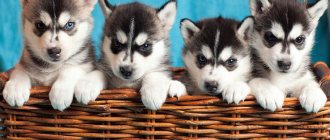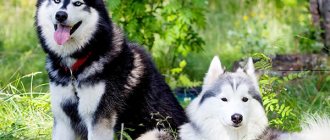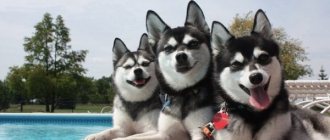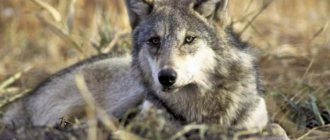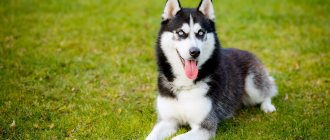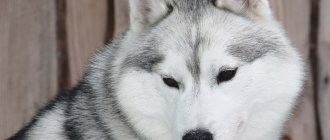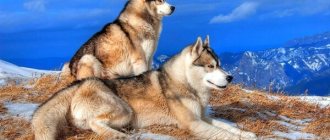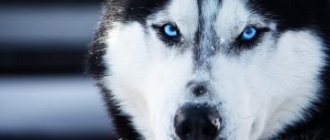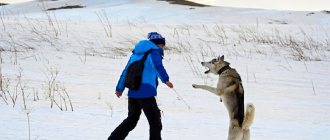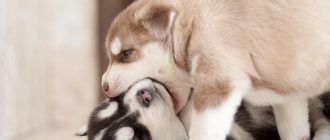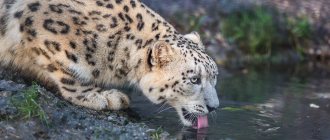Husky is an amazing dog. Many, having seen the expressive look of blue eyes in the photo and read about their good-natured character, dream of having such a pet. But representatives of this breed are not suitable for everyone. They require special conditions of detention, good upbringing and serious physical activity. After all, this is a working, sled dog, whose homeland is Siberia and the Far North. But despite this, huskies are a popular breed. People like not only her unusual appearance. Dog lovers are attracted by their unpretentiousness, friendliness, devotion and intelligence.
- pros
- Head
- Feeding rules
- What is the price
History of the Siberian Husky breed
The Siberian Husky is a dog that has been living next to humans for many centuries. It was bred by the indigenous inhabitants of the Russian Far North. The Chukchi desperately needed a dog that could cover long distances and transport people and cargo from seasonal hunting grounds to camps. Harsh climatic conditions had a decisive influence on both the formation of the animal’s structure and its character.
Husky with eyes of different colors (Heterochromia)
The spread of the breed beyond its centuries-old habitat began actively in the 20th century. The husky's endurance, ability to work harmoniously in a harness for a long time and good speed were appreciated on the American continent. Alaskan mushers increasingly began to purchase these dogs to participate in sled dog racing. The greatest fame was gained by Leonard Seppala's team, led by the legendary Togo, which did not give up the palm for several years in a row. But this musher and his dogs entered the history of mankind primarily because it was his Togo, leading a team, who covered a huge part of the path of the famous dog relay of 1925, delivering anti-diphtheria serum to Nome. A small town in Alaska, cut off from the world by miles of snowy desert, is overwhelmed by an epidemic of a deadly disease. It was not possible to get to it quickly and safely by conventional means: unfavorable weather and natural conditions were not suitable for air or land transportation. And then people turned to the faithful huskies for help. The sled relay covered more than a thousand kilometers in a record five days, and the city's population was saved. The best dogs, led by Togo, covered 146 km - the maximum distance. The dogs walked eighty kilometers on the ice of Norton Bay in forty-degree frost in a snowstorm. Such a feat became possible only thanks to the instinct, courage and endurance of the leader of the pack.
The last team in this relay were the dogs of Gunnar Kaasen, led by Balto, who got all the glory. In memory of these events, grateful people erected a monument to this dog in New York. Statues of Togo and Balto greet guests at the entrance to ClevelandMetroparksZoo, and when visiting the museum in the small Alaskan town of Wasilla, you can see Togo's embalmed body. To commemorate that incredible relay, Alaska hosts an annual multi-day sled dog race.
Husky puppy
Further development of the breed took place on the American continent, since in the 30s in the USSR the selection of sled dogs was considered unpromising.
In the USA, for a long time, special attention was paid to the sports component. The crossing of Siberian huskies with native sled dogs of Alaska led to the emergence of mixed breeds, which became much more successful than huskies in racing competitions, although they did not receive recognition from international organizations - the mixed breeds turned out to be very diverse.
A new direction in the history of the breed - exhibition - began from the moment when E. Seely and L. Demidoff first presented a bright black and white dog with blue eyes to the judges. It was since the 70s of the last century that huskies increasingly appeared as a domestic companion dog, quite suitable even for keeping in an apartment.
The return of the breed to its historical homeland, Russia, occurred in the 90s. The first dogs were imported from Belgium and the Czech Republic in 1995, and after five years the number of purebred puppies reached one and a half hundred.
Brief history of origin
The Siberian Husky is a breed that originated in the snowy expanses of Siberia and was used for centuries by northern nomadic tribes as sled dogs. It got its name from the English slang word “eski”. This is what Americans called Eskimos at the beginning of the 20th century.
Sled huskies were bred by the Chukchi in the Far North. They were used to deliver light cargo over long distances.
Unlike other tribes that bred dogs, the Chukchi perceived the dog as a companion and friend. The animal was allowed into the house, and in especially cold times it was used as a source of heat.
Expert opinion
Leonid Rodin
Experienced dog breeder
Ask a Question
They managed to confuse the history of the husky pedigree so much that as a result, the aboriginal dogs of the Russian North turned into immigrants from the American continent. We need to start with the fact that their ancestors were simply taken out by American poachers who illegally mined furs on the sparsely populated outskirts of the tsarist empire. Unpretentious and hardy local dogs turned out to be indispensable assistants in this matter. When, with the advent of Soviet power, the state took control of the borders, the hunters grabbed the dogs and went home. Thus began the second stage of this story. It was in America that they began to turn a working dog into a show star at exhibitions. Breeders worked on the appearance, as a result of which the huskies received their famous blue eyes. When they returned to Russia, everyone had already forgotten about their unsurpassed ancestors, capable of covering tens of thousands of kilometers of road in the Siberian cold. Stately, handsome huskies have conquered the world canine catwalks. But they lost the ability they inherited from their ancestors to help people survive in difficult northern conditions. They no longer win dog sled races and cannot compete with less famous working dogs, but not spoiled by a carefree life.
Siberian Husky breed standard
Today, huskies are divided into three groups - sledding, sporting (racing) and exhibition.
The official breed standard describes a sled dog. To a greater extent, British-bred huskies fall under these criteria.
Dimensions
Siberian Huskies in their element
The Siberian Husky is a medium-sized animal. The height of a dog at the withers is from 54 to 60 cm, of a female – from 51 to 56 cm. The weight of dogs is 21-28 kg and 16-23 kg, respectively. Excessive height is grounds for disqualification. The husky's weight is proportional to his height, the length of the body when viewed from the side is slightly greater than the height at the withers (extension index 110-120).
Head
The skull is small in size, rounded at the back of the head and tapering evenly towards the eyes. The bridge of the nose is smooth, the stop is clearly defined. The muzzle is of medium length, with almost the same distance from the nose to the stop and from it to the back of the head. It tapers evenly to the nose, which should be neither sharp nor square.
Huskies are characterized by a lively and interested, even with a certain amount of mischief, expression on their muzzle.
The disadvantages include:
- a sharply defined and massive head;
- the presence of an unclear transition from the muzzle to the forehead;
- black nose for gray, red and black huskies, and brown for brown dogs;
- muzzle too narrow or too wide.
Eyes
Set slightly obliquely at an average distance from each other, almond-shaped. The color of the iris is brown or blue, mosaic-colored or heterochromic options are allowed.
Disadvantages: eyes that are too close and too slanted.
Husky eyes
Ears
Husky ears are located high on the head at a short distance from each other. They stand firmly, with slightly rounded tips pointing straight up. The ears are medium-sized and triangular in shape.
Disadvantages – the ears are too large (in relation to the size of the head), the tips are directed not upward, but to the sides.
Teeth
A scissor bite is required; any deviation is a fault.
Neck
Husky muzzle
Medium length, raised on a standing animal. When moving, it bends so that the husky's head is slightly forward.
Disadvantages - too thick, as well as excessively long or short neck.
Frame
The chest is strong and deep (huskies have a fairly large heart), the ribs are widely spaced. The back is strong, with a level line from the shoulder blades to the croup. The lumbar region is elastic and tucked.
Disadvantages - too wide chest with barrel-shaped ribs, sagging back, sloping topline from the shoulder blades to the croup.
Tail
In a calm state, the husky's tail is slightly lowered and is located slightly below the line of the back. When the dog is interested or excited, it bends upward in a sickle shape, but curls into a ring, does not roll over its back or curl to the side. The coat has approximately the same length, which is why the husky's tail resembles a round fox's.
Disadvantages - too low or, on the contrary, too high, tightly curled tail.
Limbs
Brown Husky
The front ones are straight and parallel, located at a moderate distance from each other. The elbows are pressed to the body, turning neither in nor out. The bone is not heavy, but strong.
The hindquarters are parallel, moderately spaced. The knee joints are mobile, hock, have clearly defined angles and are located close to the ground.
Vestigial digits on both the front and hind legs must be removed.
Disadvantages: cow-like hindquarters, elbows turned outward, heavy large bone.
Paws
Husky paws are medium in size, oval, but not elongated. Well furred between the pads of the toes. The pads are thick-skinned. When the dog is at rest, its paws do not turn to the sides.
Disadvantages: clumsy or, conversely, too small paws, flat toes.
Wool
The husky's coat is of medium length, which, creating the effect of good furring, does not interfere with viewing the lines of the body. The undercoat is soft and dense. The outer coats are straight and smooth, but in no case coarse or erect.
Disadvantages: shaggy, hard coat.
Color ranges from pure white to black. There are white mask-like markings on the head, characteristic only of huskies.
Photos of adult huskies
Husky-like dogs
There are dogs like huskies. They have the same eyes and fur of a wolf shade: red, sand, white.
Recognized
Alaskan Malamute . Sled dogs were bred by Eskimo breeders exclusively to work in extreme, low-temperature environments. The Malamute has the features of a wolf. The male's height at the withers reaches 58 cm and weighs 25 kg.
The pet does not tolerate limited space and needs frequent and long walks.
Alaskans love children and become attached to all family members. But when training, you can’t give them any slack, as dogs sense this and become lazy. Malamutes eat little and are very clean.
Wolfdog of Saarloos . The selection belongs to the Dutch scientist Lander Sarlos, who crossed a female wolf with a male German shepherd. The wolf dog was born in 1925. It was only in 1981 that it was recognized.
The male at the withers is 75 cm, the female is 60 cm. The weight of the male is 48 kg, the female weighs 35 kg.
The dog's appearance resembles a wolf, but it loves company and is easy to train. The breed is common in Holland, where Saarloos wolf dogs are used to rescue people in unforeseen circumstances, and also as guide dogs.
The resulting breed is completely unable to bark. Dogs can only howl, like wolves.
Czechoslovakian Wolfdog . The recognition occurred in 1999, so she is considered very young. The Czechoslovakian Wolfdog is the result of crossing a Carpathian wolf with a German Shepherd. Dogs do not bark, but howl - typical wolves.
Representatives of the breed have an independent character. The owner should know about this. It is very difficult to train, but possible. During training, wolf dogs do not tolerate routine exercises, so during training it is necessary to include elements of the game.
Unrecognized
Wolfdogs . A cross between a dog and a wolf gave rise to a special hybrid - the wolf-dog. A special role in crossing belongs to Professor V.M. Kasimov. this hybrid was not recognized as a breed by any cynological organization.
The hybrid was obtained at the Perm Military Institute and is used for service on the Chinese and Mongolian borders of Russia. Border guards are distinguished by the special characteristics of wolf-dogs: the dimensions of a wild animal, highly developed intelligence, reaction speed, unpretentiousness, excellent health and developed sense of smell.
To become a good guard, wolfops need constant training. The hybrid is not suitable for keeping in the house; it is used as a service dog.
Utonogan . Translated: “spirit of the wolf.” Appeared in the UK as a result of crossing a German Shepherd with an Alaskan Malamute and a Siberian Husky. In appearance they resemble wolves, but with fluffier fur.
The hybrid is a good guard and companion dog. Thanks to their thick undercoat, representatives of the breed are able to live outside even in severe frosts.
If you buy a utonogana as a pet, you should know that representatives of the hybrid breed have a very good appetite. Therefore, when feeding, you need to decide on the norm in order to prevent obesity.
Northern Inuit. Appeared in Canada. The Canadian Husky is common in the UK. Received as a result of crossing a German Shepherd with a Siberian Husky.
Representatives of the Inuit are completely balanced dogs with good working qualities. The popularity of the dog was given by filming in the film “Game of Thrones”.
Tamaskan dog . Appeared in Finland as a result of crossing an Alaskan Malamute, a Siberian Husky and a German Shepherd. The height of a male at the withers is 70 cm, that of a female is 60 cm. The weight of a male is 45 kg, that of a female is 23 kg.
The Tamaskan communicates well with children and is friendly towards others.
Endurance and good working qualities are important characteristics of the breed. Representatives need physical activity and long walks. Undemanding in care.
Character of the Siberian Husky
Friendliness, liveliness of mind and calm disposition are the main properties of the Siberian Husky. But, speaking about these wonderful dogs, I would not like to limit myself to such a short list.
Ready for the New Year!
The ancestors of modern animals, who faithfully served man for many centuries in the harsh conditions of the Far North, passed on to their descendants all the variety of distinctive character traits and behavior that so attract connoisseurs of this breed today.
Huskies, like true sled dogs, are very active and need good, constant exercise.
Representatives of this breed are not suitable for hunting enthusiasts, despite the presence of a fairly strong instinct. For the Siberian Husky, such hunting is one of the ways of subsistence, and it will not share the prey (the dogs were fed only in winter; the rest of the time the team was grazing).
These northern dogs are pack animals, which has led to almost complete elimination of the instinct to protect their own territory, so such pets are completely unsuitable for the role of a guard. The lack of aggression towards humans, even strangers, also does not allow these dogs to be classified as guard dogs. Attempts to embitter the dog can only lead to permanent mental disorders of the animal. Nature has endowed these amazing dogs with well-developed intelligence and the ability to make independent and often extraordinary decisions. Hence the difficulties that arise during training, when certain commands require a template algorithm of actions from the husky. The use of representatives of the breed as service animals is not practiced.
The Siberian Husky is a companion dog. She is perfect for a large family; she will tenderly and reverently love all members of the household, although she recognizes only one as the leader and master. The attitude of these animals towards children deserves special attention. It is difficult to find a more gentle, attentive and affectionate friend for a child. Suffice it to recall that the Eskimos even used huskies to warm newly born babies.
One of the unusual character traits for dogs is the animal's tendency to run away. A door latch or cap hook will not become an obstacle - understanding the principle of their operation for a pet is a matter of a few days. Digging a hole under a fence, and if necessary, overcoming a high barrier is also not a problem. No one claims that your dog will systematically engage in such pranks, but you should still not forget about this feature of the husky.
Siberian Huskies in harness
General characteristics of the breed
Husky head
The unusual appearance of these animals, which is emphasized in many photographs, has become the reason for their popularity. Many people buy a puppy, believing that they will grow up to be a good-natured, obedient pet. These are really smart, calm and not at all aggressive dogs. But anyone who intends to have a Husky at home needs to know about its characteristics.
They are related to the origin of the breed. She was not bred for the home, she is a working dog. The pack instinct is genetically embedded in her. In harsh conditions, these animals often had to make their own decisions; their owners relied on their instincts. Therefore, a pet can become too independent and freedom-loving, and will not obey if it does not recognize the owner as the leader of the pack. These dogs have a strong character and strive for leadership.
This is one of the smartest breeds. The pet understands all commands, although it does not always follow them. He will respond with love to everyone who is friendly and affectionate with him, but does not tolerate rudeness. Although huskies are not aggressive, this behavior can become a problem.
The following characteristics of Husky dogs can be noted:
| Parameter | Characteristic | Rating using a five-point system |
| aggressiveness | not aggressive at all | 1 |
| activity | very active | 5 |
| training | difficult to give in | 2 |
| friendliness | friendly with everyone | 4 |
| intelligence | smart | 4 |
| attitude towards loneliness | does not last long | 2 |
| security qualities | low | 1 |
| care | simple | 4 |
| molting | sheds a lot | 5 |
| health | strong | 4 |
| noise made | barks little, but howls | 2 |
pros
Husky puppy
It is not for nothing that the Siberian Husky is becoming increasingly popular in the world. It has many advantages:
- not aggressive, calm and friendly even with strangers, will never bite;
- gets along easily with other pets;
- active, loves sports, games, takes children on sleds, runs after a ball, can perform complex tricks;
- strong, resilient;
- sociable, curious, loyal;
- loves children and always treats them with care;
- not intrusive, understands when the owner has no time for him;
- barks a little;
- trainable;
- wool does not smell at all and does not cause allergies;
- it is easy to care for;
- unpretentious, adapts to any conditions;
- is in good health;
- eats little.
Minuses
In the snow
But before you decide to purchase a husky puppy, you need to know about the disadvantages of these animals:
- they shed twice a year and lose a lot of fur;
- if left alone they can howl like a wolf for a long time;
- often run away, make digs in the enclosure or under the fence, easily open the latches on the door;
- they like to dig, because of this the plants in the yard, carpets and linoleum in the apartment suffer;
- if they are bored, they may destroy the apartment, chew wallpaper, furniture, things;
- on the street they like to pick up and eat various waste and inedible things;
- cannot tolerate heat;
- you need to walk with them a lot - at least 4 hours a day;
- stubborn, self-willed and independent;
- They do not become guards or defenders, as they are friendly to everyone.
And the main drawback is that this pet can only be owned by active, active people who have a lot of time to raise and train the animal, to walk and communicate with it. The owner must be strong-willed, with leadership qualities, capable of gaining authority.
Varieties
Huskies are very similar to wolves
Education and training
When it comes to raising and training a Siberian Husky, it is important to consider that these dogs are working dogs by nature, but not service dogs. Experts consider representatives of the breed to be good and easy to train animals. But they will obey only a recognized leader and owner - you must become an indisputable authority for the pet.
Raising a puppy should be based on two main principles - rigor and fairness. The carrot and stick policy is unacceptable. An overly gentle attitude will spoil the baby and he will “sit on your head”; cruelty will embitter the animal, which will definitely take revenge on you if necessary.
You can start training and training your dog from the age of three months. The Siberian Husky is very intelligent, and if you fail to interest him, it will be difficult to achieve results. And not because the animal does not understand you - no, he is simply not interested. The greatest effect is achieved by the training process in the form of a game. These dogs are very sensitive to the manner in which commands are given, so correct intonation is very important. You must speak calmly, confidently and clearly. Although at the same time, many owners of dogs of this breed note that huskies respond better to requests than to orders. In any case, every owner is looking for his own way to the heart and mind of his pet.
Raising any dog is impossible without a system of rewards and punishments. There are several husky misbehaviors that should be stopped immediately:
- aggressive behavior towards the owner;
- unreasonable hostility towards other dogs;
- actions that could harm the animal itself.
The best method of punishment for a Siberian Husky is to demonstrate its strength and advantage. To do this, simply grab the animal by the withers, press it to the floor and hold it until the dog stops resisting and becomes quiet. Beating as a method of education is unacceptable.
It's easier with incentives. Always praise your dog for every correct action. If you are working with a puppy, praise can be reinforced with a piece of treat. The intonation should be different from the tone in which you give commands, but do not show unnecessary emotions - huskies cannot stand high, shrill intonations.
Music
In 2011, Kuznetsov, who took the stage name Husky, tried his hand at the 9th official battle of Hip-Hop.ru, where he reached the 3rd round and lost to Another MC. In the same year, the debut video for “The Seventh of October” was posted on the official YouTube channel of the aspiring singer, who was passionately interested in politics and attended opposition rallies. The song, dedicated to the birthday of Russian President Vladimir Putin, had acute social overtones.
A couple of years after the video for the single “Cosmolet,” the rapper presented his first album, “Sbch zhizn,” for which he raised funds by working as a realtor, a builder, and a waiter, handing out leaflets on the street and writing announcements for porn videos.
In 2014, the performer met Zakhar Prilepin, participating with him in the recording of the track “It’s Time to Get Out” by colleague RICH and going to Donbass as his friend, acting as the personal photographer of Arsen Pavlov (Motorola). The musician, like Ptah, did not pass by the “Lava Fest”, organized by the writer on the front lines of the DPR.
Husky - "Bit shakes his head"
In 2015, the discography of “Yesenin of our time” was supplemented by the EP “Self-portraits”, and in 2017 - the second full-length album “Favorite songs of “imaginary” people”, which included 13 compositions and was called by the author himself “the most important thing that has been done in life.” The group “25/17” released a cover of “Bit shakes its head,” and Noize MC released a cover of “Panelka.”
In 2018, Husky delighted fans with the single “Judas” and a video for it, which became the best indie video of the year at the Jager Music Awards and was later blocked by decision of Roskomnadzor. The hip-hopper also presented “Distortion,” which consisted entirely of remixes, and “Triptych about Human Flesh.”
2019 brought a new version of “The Seventh of October”, “Swamp”, which appeared in a duet with Jeembo, “U” - the result of a collaboration with black oil, the collection “Khoshkhonog” was revealed to the world, which included “Swindler”, “Lucifer” and “Endless Store” ", released a little earlier, and "It's all hoo", containing familiar hits in a fresh treatment.
Where to start training a puppy
1. Recognizing your own nickname. The methods are quite simple. Call his name when you call your pet to a bowl of food, and after the baby wakes up, gently stroke him, saying his name. The results will not keep you waiting.
Dad with two puppies
2. Husky, as a pack dog, needs a leader, so from the first hours of being in your home, let it understand who is in charge. Moreover, be careful - even when communicating with members of your family, you must behave as an unquestioned authority, and the puppy must see this. The husky is very smart and will immediately sense if you give in to “slack” in relations with other members of the pack, and the dog perceives all household members this way.
3. Execution of the simplest commands: “Nearby!” and “Come to me!” achieved by the traditional method - with the help of tasty treats and praise.
Many owners are concerned about what to do in cases where the puppy reacts violently to strangers coming into the house: it behaves annoyingly, gets underfoot, begs for food. There is only one answer - ignore it. Don’t stroke, don’t admire (the husky is just waiting for this), but simply don’t notice. The method works flawlessly. The dog, realizing that no one is interested in him, will very soon leave for his place.
Among the general recommendations for raising and training a Siberian Husky, the following can be highlighted:
- do not forbid your pet to communicate with other dogs;
- do not pick up the dog, especially holding it belly first;
- do not tire your husky by performing the same command many times in a row;
- respect your friend and treat him fairly.
Breed traits
Breed traits (on a 5-point scale)
| Siberian Husky | |||
| Activity | in the house | 3.9 | |
| on the street | 4.6 | ||
| Obedience | training | 2.6 | |
| strangers | 3.5 | ||
| Domination | in family | 2.7 | |
| over dogs | 3.5 | ||
| Defending your territory | from people | 2 | |
| from dogs | 3.2 | ||
| Sociability | in family | 4.2 | |
| with strangers | 3.6 | ||
| with dogs | 3.4 | ||
| Concentration | in family | 1.8 | |
| in front of strangers | 1.9 | ||
| with dogs | 2 | ||
| Aggressiveness | in family | 1.6 | |
| to strangers | 1.9 | ||
| to the dogs | 2.9 | ||
| to cats | 3.5 | ||
| Family behavior | calmness | 3 | |
| demand for affection | 3.6 | ||
| excitability | 3.5 | ||
| playfulness | 4.2 | ||
| excessive barking | 2.3 | ||
| behavioral breakdowns | 3.1 | ||
| Tolerance for children | up to 4 years | 3.4 | |
| over 4 years old | 3.8 | ||
| Institutional use | watchman | 2.1 | |
| bodyguard | 2 | ||
This breed is often compared to the following dog breeds: Doberman Pinscher, Samoyed, Labrador Retriever, German Shepherd, Beagle.
Siberian Husky
Care and maintenance
When purchasing a husky puppy, you must remember that these Siberians simply cannot stay in a limited space for a long time. Any attempt to turn your pet into a “couch” dog is doomed to failure. Movement, active games, good physical activity, long walks - these are the elements of these magnificent animals.
Husky on a leash
In order for the energy of a dog, especially one living in an apartment, to be directed in the right direction, experts of the breed recommend loading the Siberian Husky to the fullest. Otherwise, the comfort of your home may be seriously damaged. One of the options may be to keep the dog in a cage. Accustomed to this state of affairs from an early age, the husky will react to this quite calmly. Another thing is that for a loving owner, the sight of a friend sitting behind bars will not evoke positive emotions at all, so the best way out still seems to be to “load” the pet to such an extent that he simply does not have the strength for domestic pranks.
Maintenance in a country house also has its own characteristics. Remember that huskies are dogs from harsh regions, and being on the street is not a burden for them. Many owners note that even in severe frosts, animals rest and sleep in the snow, and not in a booth - the spirit of the Arctic reminds of itself.
Be sure to provide your pet with a spacious enclosure. Just don’t use chain-link for this: in a matter of days, the Siberian Husky will turn it into hanging rags. For fencing, use wire at least half a millimeter thick. It is better to lay the floor with natural stone, because these dogs are great experts in digging and will not fail to demonstrate their talent in this matter. If you think that an enclosure is unnecessary, make sure that the fence of your area is a reliable barrier in the way of the husky in his desire to explore and travel far.
The best thing is to find time to take your dog for much-needed walks.
What do you need to purchase before bringing your pet into your home? First of all, these are a couple of bowls for water and food, special “chew” toys, and a rug on which your friend will rest. A little later you will need to buy equipment such as a collar, leash and muzzle. A halter can also come in handy - with its help, even a child can control a Siberian Husky.
Character and intelligence
By nature, the Siberian Husky is willful and stubborn. In a hopeless situation, he makes his own decisions. And all this thanks to high intelligence.
Huskies are often called the "runaways" of the dog world and are incredibly adept at escaping. Owners should be vigilant in checking their areas for areas where dogs can escape and ensure they are surrounded by a strong fence.
To overcome the wolf roots and adapt the dog to yourself, you need a strong character; the dog will not obey a weak-willed owner.
Originally used to pull sleds, this athletic breed requires regular exercise to prevent boredom. For those who dream of a calm dog who spends all his time on the couch, a husky is not suitable. The Siberian Husky is constantly moving, so it cannot be confined to 4 walls. If you don't give your dog enough open space, the dog will start to freak out and become unbearable.
Their affectionate nature makes them great with children and other pets.
Almost always, the Siberian Husky is friendly, but when his instincts are “tamed”, the friendship ends. If you don't take your dog out for a walk on time, you can end up with chewed shoes and shabby pillows.
It is not recommended to keep a dog on a leash all the time, however, in order to avoid leaving home, it is still recommended to tie a young dog in the absence of the owners, otherwise the husky may simply go “in the air.”
When kept in an apartment, a puppy can do a lot of mischief, for example, chewing off all the shoes, tearing off the curtains, and rolling up all the carpets on the floor. During walks, dogs dig holes, and this behavior is explained by their origin, because in their homeland they dug up snow in order to spend the night in the resulting holes.
Attitude towards children and others
Husky gets along well with kids. The northern peoples had a tradition of letting a dog into the yurt after the birth of a child, so that it would warm the newborn with its warmth. Siberian Huskies love to play with children and ride them on sleds around the yard; the dogs exhibit protective qualities.
However, you should not leave preschool children with a husky, as the dog’s excessive activity can lead to undesirable consequences and even injury.
Training and education
Socialization will be successful if you start raising your dog from an early age. It is advisable to walk at a time when other couples with dogs are walking along the street, as the husky loves company and is sociable. The Siberian Husky is friendly, treats well not only family members, but also everyone around him, so it is useless to train the dog to guard the territory.
First time dog owners should think carefully before purchasing as Huskies can be very independent and difficult to train.
Special rules have been defined for training representatives. When educating, it is necessary to patiently and persistently demand that the command be followed. It is recommended to move on to teaching a new command only after the dog has mastered the first one. The stubbornness of the dog does not allow the owner to understand whether he has learned his lesson or not.
Huskies cannot be forced to obey unconditionally. She must know what she can do and what she is not allowed to do.
Dogs get along well with teenagers, so a 12-14 year old guy can raise a puppy or an adult. One requirement is good physical preparation so that he can resist a strong dog.
Use of husky in everyday life
Initially, the first representatives were bred to transport people and luggage over long distances. Man's friend can reach great speed. The main characteristics of a husky are endurance, speed of reaction and strength. The husky looks elegant when running.
Husky in harness
Huskies are not used as a guard, as she does not like to bark and treats everyone kindly.
Is the Siberian Husky suitable for hunting?
All dogs that have wolf roots have hunting instincts. But for a husky to be a real hunter and show excellent instincts, hunting skills will have to be developed from an early age. First, a small puppy must be taught to follow commands, and then begin training so that the pet brings game to the owner.
If you develop hunting skills in Huskies in time, they will become excellent hunters, better than huskies.
What and how to feed huskies
Until the age of two months, the puppy is fed 6 times a day, up to 4 months - five, up to six months - four, then - three times a day. From ten months onwards, it will be enough for a Siberian Husky to eat twice, and an adult animal (over one and a half years old), depending on physical activity, eats once or twice a day.
Most experts agree that it is better to feed your four-legged friend dry food and special canned food. These must be premium and super-premium products. Cheap food contains a high content of starch, which is not very beneficial for these northern dogs.
You can immediately see who was visiting grandma
Until the animal reaches 10 months of age, “puppy” food will be sufficient for normal development; for adult huskies, balanced food for breeds with high physical activity should be used.
Even when using the highest quality feed mixtures, breeders recommend carefully monitoring the dog’s condition in order to make timely adjustments to the menu if necessary.
Organizing a husky’s proper nutrition with natural products is somewhat more difficult. Up to 60% of the diet should be meat (raw or slightly scalded). The best choice - beef, rabbit and turkey - are possible, it is better not to mess with chicken due to the high risk of allergic reactions, pork and lamb should be completely excluded. Eggs, or rather boiled and raw egg yolks, can be added to porridge a couple of times a week; vegetables, with the exception of potatoes, are also healthy. It is better to give dairy products only in their sour versions. Don't forget to add a little vegetable oil and fish oil to the food.
No matter how varied you feed your Siberian Husky, you cannot do without vitamin supplements. Your veterinarian will tell you about their correct use.
Pet hygiene comes down mainly to coat care, especially during shedding, as well as monitoring the condition of the teeth. To keep them white and smooth, clean the stone and plaque in a timely manner. This can be done both at home and in the clinic.
But huskies do not need bathing. Their fur is capable of self-cleaning, and this dog does not have a “dog spirit”. It is water procedures that provoke the appearance of an unpleasant odor, which can lead to disruption of the fat balance of the skin and coat.
Proper care and maintenance is the key to your friend’s well-being and longevity.
Features of caring for a husky
Although this dog is unpretentious, it needs care. It is simple, but without it the pet will be uncomfortable and may get sick. Routine animal care activities will be required.
- Comb 1-2 times a week with a long-toothed comb and brush the coat. During shedding, brush the undercoat daily with a slicker brush.
- You need to brush your teeth regularly. In modern dogs, tartar builds up quickly. Therefore, it is recommended to buy paste and a brush at the pet store. To clean the teeth, you also need to give your pet special treats and bones.
- Check your ears and remove dirt and excess wax if necessary.
- If discharge accumulates in the corners of the eyes, wipe them with a cotton pad moistened with boiled water.
- Usually in the city, your pet's claws get worn down on the asphalt. But it is recommended to check them regularly and trim them if necessary.
- Huskies don't need to be bathed often. They are clean, lick themselves like cats. If necessary, they wash their paws. Bath when heavily soiled, but not more than 2-3 times a year. You can simply wipe the wool with a damp cloth.
- Carry out helminthiasis prevention 2-3 times a year. Wear a flea and tick collar.
Feeding rules
A husky's diet should be complete; the animal's health and appearance depend on it. It is best to feed him high-quality dry food. It must be super premium. When choosing food for your husky, it is recommended to consult a veterinarian. Acana Advance, Arden Grange, Brit Care, Eukanuba and other varieties designed for active dogs are suitable. They contain all the necessary vitamins and minerals. If the chosen food is not suitable, the food needs to be changed.
Husky appearance
It is more difficult to create a natural diet. It must include at least 70% meat. It is given boiled or scalded with boiling water. Low-fat varieties without bones and skin are suitable. It is acceptable to give fish occasionally, just be sure to remove the bones. When feeding natural food, they give porridge; about 10% of the diet should be vegetables. You need to add vegetable oil to food, give yolk, fruit, and fermented milk products. Instead of bones they give cartilage.
You should not feed your dog the following food:
- pork, lamb;
- pasta, bread;
- sweets, chocolate;
- smoked meats, sausages;
- potatoes;
- milk.
It is necessary to give your dog treats. With natural feeding, these are dried offal, dried meat, ears, cartilage. If your pet eats dry food, these are industrially produced dog biscuits and bones.
You cannot mix two types of food, so it is advisable to decide on it before purchasing an animal. You need to know how many times to feed your pet. Puppy 5-6 times, adult dog twice a day. The amount of food depends on age, weight and physical activity. Animals kept outside need more food in winter. For any feeding method, it is recommended to give the animal vitamin and mineral supplements.
Possible diseases
Huskies rarely get sick. This is due to their genetic characteristics. Sometimes the following diseases may occur:
- diabetes;
- neurological diseases;
- eye diseases;
- dermatitis;
- allergy;
- joint dysplasia;
- epilepsy.
Health and disease of the Siberian Husky
As a true child of high northern latitudes, the Siberian Husky is distinguished by good health.
However, this does not mean that the owner should not monitor the condition of his pet. When purchasing a puppy, study the pedigree of its parents and check if there were any genetically transmitted diseases in its family. For dogs of this breed, most often these may be diabetes mellitus or problems with the thyroid gland, some eye diseases (glaucoma, corneal dystrophy, cataracts), and hip dysplasia. Sometimes Siberian Huskies suffer from epilepsy. This disease cannot be completely cured, but proper care will reduce the number of attacks. Timely and complete vaccination and careful monitoring of the dog’s condition will help avoid the occurrence of most health-related problems.
It is recommended to periodically examine the animal’s ears, eyes and teeth, and monitor the condition of its fur. Don't ignore your husky's gait. Lameness can be the result of either muscle damage or incipient problems with the musculoskeletal system.
Monitor your dog's weight. Both obesity and wasting are equally harmful.
Timely deworming is very important for the Siberian Husky, especially considering the tendency of dogs of this breed to eat feces (any attempts should be strictly suppressed).
Keeping in mind the northern origin, during summer walks try to choose the coolest and shady places.
If you experience any signs of discomfort, you should immediately contact your veterinarian.
With good care and proper maintenance, the life expectancy of a husky can be more than 15 years.
Huskies love sausages
Nutrition
Huskies eat the same foods as other dog breeds. This can be ready-made food, or natural, independently prepared. Dry ready-made ones must be selected taking into account age and breed.
When feeding natural products, it is necessary to adhere to a balanced diet containing vitamins and beneficial components. The basis of the diet should be protein and fat foods.
Natural food should include meat every day, preferably beef. It is not recommended to feed pork and lamb. Meat should be given in pieces; there is no need to grind it into minced meat.
You can give fish, preferably sea fish. In addition, different types of cereals should be present - rice, millet, buckwheat. Cooked food should be warm. It is important that there is always water available in an accessible place. Mixed types of natural and dry feeding are unacceptable. You should feed immediately after a walk.
Husky eats poultry
How to choose a puppy
The main rule is that you can only buy a baby in specialized nurseries or from well-known breeders. This will give you much more guarantee that the grown animal will fully comply with breed standards and be in good health. Buying a husky puppy online or on the market is completely out of the question. Even if they really offer you a purebred baby, how can you check in what conditions the dog was kept, what the puppy, as well as its parents, were fed? No one can guarantee you correct and timely vaccination. And these are all the components of your pet’s future health.
Purchasing a Husky puppy from a breeder or kennel has other benefits. Firstly, you get the opportunity to directly communicate with all the puppies of the litter, evaluate their character, temperament and intelligence. Secondly, gain a lot of important information about the behavioral characteristics of animals, their diet, and habits. An experienced and responsible breeder will definitely answer all your questions, ask why you chose a Siberian Husky, and give practical advice on care and maintenance. Thirdly, a puppy from a nursery or from a recognized breeder must have all the necessary accompanying documents, from a pedigree to a veterinary record with data on vaccinations and deworming.
A Siberian Husky puppy can be taken home at approximately two months of age. Try to meet your baby as often as possible, walk and play with him. Many breeders recommend taking an older animal - the dog already has some skills and is more disciplined, and the new owner will simply have a little less educational tasks at first.
It will also be useful to know that each husky raised in a kennel has its own brand. It is usually placed on the inside of the dog's ear or on the dog's belly.
Biography of rapper Husky
The rapper Husky, who quickly conquered the musical Olympus, is considered a typical hero of modern times and is even compared to Sergei Yesenin.
He quickly turned from an ordinary Siberian youth into a metropolitan hip-hop star, repeating the fate of the famous poet, and even earned praise from the star of the domestic rap scene Oksimiron. Husky's real name is Dmitry Kuznetsov
He became known to the general public after the premiere of the video “October 7,” released for Vladimir Putin’s birthday.
The opinion of connoisseurs of the genre about Husky is divided: some call it reliable Russian rap, others consider it outright “jeans” and a purely production project. His friendship with the writer Zakhar Prilepin and his trip to Donbass also caused a lot of controversy.
Photos of Siberian Husky puppies
Questions and answers
How much should a husky puppy weigh from 1 month to a year?
At 1 month, a hasyat weighs 3 kg, a two-month-old husky weighs 5-6 kg. Every month their weight steadily increases by several kg. So, at six months the puppy already weighs 15-21 kg, at 9 - 18-27 kg, and at one year - 23-28 kg.
To what age do Hasyats grow?
Until six months of age, Khasenys usually grow at the same pace. And then females and males begin to develop differently. Girls actively grow in height until they are eight months old, and then continue to grow gradually until they are one year old. Weight continues to increase until two years of age. Males grow up to nine months. The final growth of a male dog is formed by one and a half years. He becomes an adult only at two or three years of age.
How much does a Siberian Husky cost?
There are several factors that influence the cost of husky puppies.
This includes the presence of a pedigree, the individual qualities of the baby (appearance, physical fitness, gender), and the status of the parents. It is clear that the cubs of champion dogs - in the case of huskies, not only for exhibitions, but also for sports competitions - will cost much more than the babies of ordinary parents. If you just want to have a friend at home and don’t bother with a show career, your choice is a pet-class puppy. It will cost 20-25 thousand rubles. Most likely, it will be sold without a pedigree, but will that stop you?
Breed-class dogs already cost from 30 thousand rubles. They have all the necessary documents and are quite suitable for breeding work. Some minor deviations from the breed standard are possible.
The most expensive are show class puppies. Such animals fully comply with official standards, have no flaws and are born husky champions. The price for a dog of this class can be more than 60,000 rubles. Buying a baby without the advice and help of an experienced breed expert will be very problematic.
When planning to buy a Siberian Husky, do not chase the low price. On the contrary, such a proposal should alert you. Most likely, ordinary deception or dishonesty is taking place. A husky puppy, taking into account the costs the breeder incurs when breeding this breed, simply cannot be cheap.
Scandals
On September 11, 2018, a provocative video appeared on Kuznetsov’s personal page on the social network Instagram, where he deleted the finished album “The Gospel of the Dog.” The collection, which told “a conceptual story about Jesus Christ in Moscow in the 1910s,” was announced back in 2017.
The next day, the Russian media was full of headlines that “Husky “hanged himself” on the balcony of the Ritz-Carlton in Moscow.” As it turned out later, his own body hanging from the balcony on the top floor of the building turned out to be an act of the musician, because of which he and his friend Ruslan Hartaev had to go to the police station.
On September 15, an alarming post was published on the rapper’s official public page on VKontakte, announcing a farewell ceremony for him in the large hall of the Stimul cultural center. On September 16, at the indicated time and in the indicated place, throughout the entire “event” he lay in a coffin, at the end opening his eyes.
View this post on Instagram
A post shared by DEN DAN “KIND”! (@den4ello)
Husky with hair
On November 22 of the same year, Husky was arrested for 12 days under the article of petty hooliganism for the fact that the day before, after the cancellation of a concert in Krasnodar, he climbed onto the roof of someone else’s car and tried to perform one of his songs. Many celebrities spoke out in defense of the singer, and as a result, the offender was released from custody after 4 days, and the sentence was overturned.
On December 12, the Sovetsky District Court of Krasnodar ordered the blocking of three more hip-hop videos (“Poem about the Motherland,” “Bullet the Fool,” and “Pyromaniac 17”) on YouTube and VK, in addition to the already banned “Judas.”
How to determine the age of a dog
The age of a dog is determined by its teeth. This is a completely reliable technique, allowing for an error of 2 years.
The number of years lived is determined as follows:
- 1–2 years of life. The molars are white and sharp. There are trident-shaped protrusions along the edges.
- 2 years. The sharp protrusions begin to wear off.
- 4 years. The teeth acquire a grayish tint and become less shiny.
- 5 years. Molars turn yellow, fangs become dull.
- 6–8 years. The incisors become concave. The fangs become duller even more. Possible stone formation.
- 8–10 years. The fangs are made shorter. The incisors are shaped into ovals. The enamel color turns yellow.
- 12 years old. Molars may become loose and fall out.
Indirect signs can also help in establishing age:
- Wool. In young individuals the cover is thick and shiny. In older people it is rougher and more brittle.
- Eyes. With age they become cloudy and lose their shine. Older pets are often susceptible to cataracts and other eye diseases.
- Mobility. Young dogs are livelier and more energetic than older ones.
Important! As Huskies age, they lose muscle tone and become prone to obesity.
With this calculator you can find out the age of your dog by human standards. Read more.
Character[ | ]
Friendly and calm, but at the same time alive.
It is not advisable to lock Huskies in an apartment, although this practice is not uncommon; the animal is extremely active and demanding of attention. On average, a dog needs 15 square meters to live comfortably. Huskies make excellent nannies for children, all thanks to the tolerance and friendliness of this breed.
The dog is categorically unsuitable for use as a hunting dog (hunts, but does not bring prey), guard dog (the instinct to protect the territory is reduced to a minimum) and security dog (normally, these dogs have absolutely no aggression towards humans). The dog is too independent, so it is not well suited for the role of a service dog.
Attempts to unblock aggression towards a person, as a rule, end in obtaining a dog with a disturbed psyche, which, given the physical capabilities of this dog, poses a danger to others. This breed should absolutely not be used as a guard dog.
The Siberian Husky easily settles into a new place and is well suited for apartment living. He has excellent mental abilities that require almost no additional development, but frequent games and activities are recommended. Recently, this breed has become very popular due to its unusual appearance. However, huskies require a lot of physical activity, long walks and regular “mental exercise” (obedience classes, Frisbee, agility[9], hiking in new places for the dog, etc.)
Siberian Huskies have a tendency to run away. There is a known case when a dog, locked in a rural house, broke out the glass with its muzzle, jumped out the window and went to look for the rest of its “pack”. In addition, they quickly learn to open doors[10], they are excellent diggers, jump well and are able to climb even over a high fence[11], which makes it difficult to keep them within the fenced area.
What living conditions are required for huskies?
When a puppy arrives in the house, give him his own place with a bed or mattress where he will rest and feel safe.
Puppies will really like different balls and other toys with which they can have fun. Otherwise, they can chew off everything that falls into their mouth. Huskies also have one more “hobby” that may not appeal to everyone. Many dogs of this breed love to dig. They are not averse to rummaging even in flower beds and beds or digging into a neighboring plot, and in search of adventure they can easily jump over a low fence.
Particular attention should be paid to the physical form of The Siberian Husky animals. Huskies are active, full of energy dogs that will not be comfortable within the four walls of an apartment without active walks and training. Constant and intense physical activity, performed under human supervision, will help the dog stay in good shape and strengthen its bond with its owner.
Photo: skvortsova/Depositphotos
The dogs are also enthusiastic about sledding. The disciplines in such competitions are different. Among the traditional winter ones are classic sled races over distances of different lengths, as well as skipuling and skijoring. Snowless competitions (dryland) are also held. So, in canicross, huskies pull a running athlete behind them, and during bike joring, the animals move in conjunction with the cyclist.
Save
